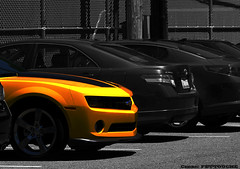 |
| Image via Wikipedia |
The 2012 Ford F-150, which established a new standard for full-size
pickups with best-in-class fuel efficiency and capability, today was
named Motor Trend’s 2012 Truck of the Year®.
“The 2012 F-150 is a no-compromise solution that can be tailored to fit virtually every customer’s needs, and the Motor Trend
Truck of the Year award further reinforces that this is truly the best
choice for America’s truck owners,” said Mark Fields, Ford president of
The Americas. “We are proud to receive this award and even more pleased
that our F-150 customers have additional validation of their top
choice.”
This is the fourth time the F-150 has won the award – the most awards for any truck since Motor Trend
began presenting its Truck of the Year award in 1989. The Ford pickup
received the magazine’s prestigious award for previous groundbreaking
new models in 1997, 2004 and 2009.
Motor Trend editors applauded F-150 because, they said,
“F-150s are built to work and felt better the more they were challenged.
Ford offers an enormous variety of configurations and designs, making
the truck tailorable to just about any need. It’s the combination of
advancement in design, engineering excellence, efficiency, safety,
value, and the performance of intended function that has earned the Ford
F-150 the title of Motor Trend’s 2012 Truck of the Year.”
With more than a half-million sales through November and a lead of
almost 150,000 sales versus the nearest competitor, the Ford F-Series is
on track this year to extend its streak of truck leadership to 35
straight years.
Helping spark the F-150’s continued success is the powerful and fuel-efficient 3.5-liter EcoBoost®
engine, which now accounts for more than 40 percent of F-150 retail
sales and is on pace to exceed 100,000 sales in less than a year on the
market.
More capability, more technology
The 2012 F-150 offers customers plenty of technologies that boost
capability, performance, driving enjoyment and fuel efficiency. One such
technology is the class-exclusive electric power-assisted steering
(EPAS). The system has been carefully tuned with sophisticated speed
mapping to deliver accurate responses at high speed while remaining
light and manageable in parking maneuvers. Ford is the first
manufacturer to widely offer EPAS on full-size pickup trucks. EPAS
contributes about a 4 percent fuel-economy benefit compared with
conventional hydraulic systems.
A 4.2-inch LCD message center that features information related to fuel economy, towing performance and off-roading, SYNC® AppLink™ and SiriusXM Travel Link also are among the customer conveniences available.
New features for 2012 include:
- 36-gallon fuel tank on 4x4 F-150 EcoBoost-equipped units providing best-in-class 756 miles of driving range
- Two-speed automatic 4x4 system on Lariat, King Ranch, Harley-Davidson and Platinum models for improved all-weather traction
- Hill Start Assist, which helps keep the truck from rolling backward at a stop, making it easier to pull away when on a slope or hill, especially when towing
- Best-in-class payload capability of 3,120 pounds
Fuel-efficient and powerful offerings
All of the changes for the 2012 model year complement a powertrain lineup that debuted in 2011. The powertrain lineup delivers a mix of best-in-class fuel economy, horsepower, torque and capability. Ford is also the first and only manufacturer to equip its entire full-size pickup truck lineup with a fuel-saving six-speed automatic transmission as standard. Engine highlights include:
All of the changes for the 2012 model year complement a powertrain lineup that debuted in 2011. The powertrain lineup delivers a mix of best-in-class fuel economy, horsepower, torque and capability. Ford is also the first and only manufacturer to equip its entire full-size pickup truck lineup with a fuel-saving six-speed automatic transmission as standard. Engine highlights include:
3.7-liter four-valve Ti-VCT V6:
- Best-in-class 302 horsepower at 6,500 rpm vs. V6 competitors
- Unsurpassed 278 lb.-ft. of torque at 4,000 rpm vs. V6 competitors
- Best-in-class 17 mpg city and best-in-class 23 mpg highway (4x2)
- Best-in-class 6,100 pounds maximum trailer tow vs. V6 competitors
5.0-liter four-valve DOHC Ti-VCT V8:
- Best-in-class 360 horsepower at 5,500 rpm vs. standard V8 competitors
- Best-in-class 380 lb.-ft. of torque at 4,250 rpm vs. standard V8 competitors
- 21 mpg highway, unsurpassed 15 mpg city (4x2)
- Best-in-class 10,000 pounds maximum trailer tow vs. standard V8 competitors
6.2-liter two-valve SOHC V8:
- Best-in-class 411 horsepower at 5,500 rpm vs. all competitors
- Best-in-class 434 lb.-ft. of torque at 4,500 rpm vs. all competitors
- 13 mpg city, 18 mpg highway (4x2)
- Best-in-class 11,300 pounds maximum trailer tow vs. all competitors
3.5-liter Ti-VCT EcoBoost:
- 365 horsepower at 5,000 rpm on regular fuel
- Best-in-class 420 lb.-ft. of torque at 2,500 rpm vs. premium V8 competitors
- Up to 90 percent peak torque available from 1,700 rpm to 5,000 rpm
- 22 mpg highway, 16 mpg city (4x2)
- Best-in-class 11,300 pounds maximum trailer tow vs. all competitors
- Best-in-class 3,120 pounds payload vs. all competitors









